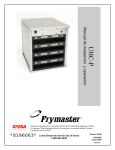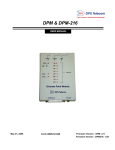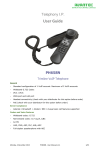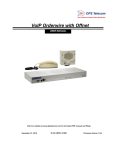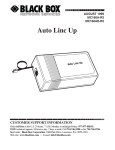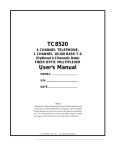Download FDO 1000 Order-Wire (Packages*)
Transcript
DPS Telecom User Manual FDO 1000 Order-Wire (Packages*) Fig. 1 - FDO 1000 Order-Wire Terminal with Adaptive PCM card interfaces 24 Kbit channel. Call Buzzer A buzzer in the order-wire announces incoming calls. An optional buzzer can be installed in the phone. External speaker The FDO 1000 includes a 2-watt speaker amplifier that can be used to drive an external eight ohm speaker. A paging feature can be activated from any calling station to allow the desired party's name to be announced over the speaker. Passive Bridge, Optional Active Bridge. The FDO 1000 is facility-ready, with a built-in 4-Way passive bridge and level matching pads for +7 / -16 dBm channel levels. The bridge can also be bypassed for direct interface at the order-wire's active VF ports. An accessory active bridge can be installed on the order-wire's P.C. board for matching levels other than +7/-16 dBm. Network Control In privacy modes, the FDO 1000 uses automatically generated DTMF tones to control access to the order-wire FDO 1000 Order-Wire Description With DPS' FDO 1000 Order-Wire terminal, your analog or digital network can become your own private phone system, with links to the public telephone network. The order-wire is an economical party-line system that requires no central switching. An order-wire terminal and telephone are located at each facility in your network. The order-wire system is simple to operate and can significantly reduce your voice communications costs. DTMF Selective Signaling The DPS FDO Order-Wire uses the on-board microprocessor to synthesize and decode DTMF signaling tones. The FDO can be programmed for automatic privacy, manual privacy, no privacy and hoot-n-holler operating modes. Digital Interface The FDO 1000 order-wire can be equipped with an Adaptive PCM (ADPCM) digital interface card in the expansion card slot. This interfaces the order-wire to a 24 Kbit port on DPS' DVF-64 digital VF interface card. LED Indicators Front panel LEDs indicate order-wire off-hook, incoming call ringing and channel busy. Front panel test points and level controls are provided for calibration. Addressing The Order-Wire responds to one, two or three digit addressing. Leading zeroes in the address will set it for one or two digits. Rotary switches on the P.C. Board allow the address to be easily set. The station address is posted on the front panel with stick-on labels (labels are included). Four-Wire Phone Voice communications and out-dialing occur at a 4-wire telephone, mounted near the order-wire. Table of Contents Description . . . . . . . . . . . . . . . . . . . . . . . . . . . . . . . . . . . 1 Adaptive PCM (ADPCM) . . . . . . . . . . . . . . . . . . . 2 Applications . . . . . . . . . . . . . . . . . . . . . . . . . . . . . . . . . . 3 Applications with the ADPCM . . . . . . . . . . . . . . . 3 Operation Modes . . . . . . . . . . . . . . . . . . . . . . . . . . 4 Shipping List . . . . . . . . . . . . . . . . . . . . . . . . . . . . . . . . . 8 Installation . . . . . . . . . . . . . . . . . . . . . . . . . . . . . . . . . . . 8 Reference Figures . . . . . . . . . . . . . . . . . . . . . . . . . . . . . 8 Test and Acceptance . . . . . . . . . . . . . . . . . . . . . . . . . . 22 Change Notice 2-8-99: Added ADPCM LEDs info. 3-1-99: Converted to user manual, general corrections, clarified term./rptr. switch, added Table J. 5-17-99: Added center-fold, model chart and glossary. FDO 1000-11A-0V/ADPCM May 17, 1999 Specifications . . . . . . . . . . . . . . . . . . . . . . . . . . . . . . . . 24 Options and Model Numbers . . . . . . . . . . . . . . . . . . . 24 * See Table J on page 24 for a listing of packages that use the FDO 1000 Order-Wire. 1 UM110339 Trimline Type Wall Phone *4-1/2" square box can mount on rack side rail or any flat surface Speaker with Level Control* 2 Wires Direct Port 4-Wire VF Line 4 Wires 4 Wires Fig. 3 - Accessories for Order-Wire include active 4w/4w bridge, 4-wire DTMF phone and speaker. FDO-1000 Order-Wire Terminal (shown with ADPCM digital interface card in expansion slot) Wire-Wrap and Connectorized Back Panel All network, power and ancillary connections are made at wire-wrap blocks and connectors on the back panel. An RJ-12 jack is provided for the phone and screw-terminal barriers are provided for the power (office battery). voice input/output, bridge port connections, fuse alarm, external buzzer, speaker and M lead connections are all provided on a 60 pin wire-wrap block. Fig. 2 - Order-wire packages include external speaker, phone, ADPCM and rack-mount housing. network. An off-hook tone is generated when a caller picks up the phone, which causes other stations on the network to assume a busy state. If any other phone is picked up during the busy state, a busy signal will sound in the earpiece. Busied stations remain in that state until their station code is dialed from the caller's phone or until the caller hangs up, generating an on-hook tone. Adaptive PCM (ADPCM) DPS’ Adaptive PCM (ADPCM) provides a digital interface for voice frequency signals in the 300 to 4KHz bandwidth, particularly order-wire. It digitizes the voice to a 24 Kbit channel that is passed on to a DVF-64 card in FDO1000 Order-Wire Order-Wire Electronics FDO1000 Order-Wire ADPCM ADPCM DVF-64 DVF-64 Order-Wire Electronics Speaker Speaker 4-Wire Phone 4-Wire Phone Digital Network FDO1000 Order-Wire Order-Wire Electronics FDO1000 Order-Wire ADPCM ADPCM DVF-64 DVF-64 Speaker Speaker 4-Wire Phone Order-Wire Electronics POTS Line to PSTN FDO 3000 Off-Net 4-Wire Phone Fig. 4 - A typical analog order-wire network provides voice communications between telecom sites and to the Public Switched Telephone Network (PSTN) via a Plain-Old Telephone Service (POTS) line. UM110339 2 FDO 1000-11A-0V/ADPCM May 17, 1999 OW Chan. OLS or OT OA A Terminal FDO 1000 Order-Wire Order-Wire FDO 3000 Off-Net eq/w with Off-Net DVF-64 Expansion Card Off-net Phone Line A-Chan. OA OA B OLS or OT OW Chan. Terminal FDO 1000 Order-Wire FDO 3000 Off-Net eq/w Order-Wire DVF-64 Expansion Card with Off-Net Satellite TABS with Order-Wire FDO 1000 Order-Wire KDA 864-TABS eq/w DVF-64 Expansion Card Front Door RS422 TABS (1200 Baud) TABS A TABS A B Satellite TABS with Order-Wire NTP TABS TABS B Back Door Off-net Phone Line RS422 TABS (1200 Baud) B-Chan. Satellite TABS with Order-Wire FDO 1000 Order-Wire KDA 864-TABS eq/w DVF-64 Expansion Card FDO 1000 Order-Wire KDA 864-TABS eq/w DVF-64 Expansion Card NTP Fig. 5 - The ADPCM digitizes order-wire to put it on SONET. NOTE: A more complete network diagram is shown in Fig. 20. an adjacent housing. The DVF-64 assembles the 24 Kbit data with other signals and places it on the 64 Kbit overhead on a SONET or other digital network. The ADPCM fits into the expansion card slot on the FDO 1000 Order-Wire. Two separate circuits are included on the module, with a switchable bridging network that allows the two circuits to perform in a either a terminal or a repeater application. An FDO 3000 Off-Net can be connected to the second circuit to adapt the order-wire to a 2-wire POTS line in the Public Switched Telephone Network. ADPCM Connectors When the order-wire chassis is equipped for an ADPCM digital interface card, the back panel includes connectors for interfacing the DVF-64 card in a companion shelf. Access to the ADPCM order-wire ports is provided at the wire-wrap block. Each site should be equipped with a 4-Wire DTMF phone and external speaker. Wire-Wrap Jumpers To utilize the order-wire's four-way bridge or the ADPCM, jumpers must be installed at the wire-wrap block. When the application details are known at the time an order is placed, these jumpers will be installed at the factory. Order-Wire KDA network element DVF-64 Fig. 6 -Satellite KDA package w/Order-Wire. Order-Wire Packages with the ADPCM The FDO 1000 Order-Wire with ADPCM can be combined with a DPS KDA 864-E2A or KDA 864-TABS network element for alarm applications via SONET. The DVF-64 card resides in the expansion card slot of the KDA chassis. (Figs. 5, 6, 23 and 27) The FDO 1000 Order-Wire with ADPCM can be combined with a DPS KDA housing with a blank module and Applications The FDO 1000 is available in application packages that include KDA alarm network elements and the FDO 3000 Off-Net. Details on the currently available packages are provided later in this document. DTMF Selective Signaling Fig. 2 shows the basic components of the order-wire terminal. Station call codes are programmed manually with rotary switches on the order-wire P.C. board. Number labels are provided to place on the front panel to indicate the setting. FDO 1000-11A-0V/ADPCM May 17, 1999 ADPCM Order-Wire ADPCM Blank Module DVF-64 Fig. 7 - Satellite Terminal package w/Order-Wire. 3 UM110339 Automatic Privacy 1. Off Hook Busy 222 Muted Dial Tone Busy Tone Muted Off Hook 111 Off Hook Tone (#) Muted Busy Voice Facility 333 Muted Busy 444 2. Dial Station Code DTMF Tones (side tone) Muted Busy Busy Tone 222 Muted Off Hook 111 333 Voice Facility Dial Code Muted Buzzer Ring 333 Muted Busy 444 3 3 3 DTMF Tones (side tone) Busy 222 Muted Off Hook 111 8333 Voice Facility Dial Code Joe Smith! Ring 333 Muted Busy 444 8 3 3 3 3. Call Answered Off hook tone Talk Busy Tone Muted 2a. Alternate dial w/page (8 + station code) Muted Busy Tone Muted Off Hook Off Hook Tone (#) 111 Busy 222 Voice Facility Muted Off Hook Talk 333 Muted Busy 444 4. Call Terminated (system normal) Unmuted 111 Unmuted 222 On Hook Tone (*) On Hook Tone (*) Voice Facility Unmuted 333 Unmuted 444 Fig. 9 - Order of operation in the automatic privacy mode. connection to SONET. The DVF-64 card fits in the expansion card slot of the off-net chassis. (Figs. 5, 8 and 22) An expansion package is available to add an order-wire to a site with an existing KDA network element. (Fig. 25) a DVF-64 card to make a “satellite terminal” to provide voice and E2A/VF interface to SONET. (Figs. 7. and 25). The FDO 1000 Order-Wire with ADPCM can be combined with an FDO 3000 Off-Net to make a "terminal order-wire with off-net" for interfacing voice and a PSTN Order-Wire Off-Net Operation Modes Automatic Privacy Refer to Fig. 9. In the automatic privacy mode the FDO order-wire performs like a normal private line telephone. The caller hears dial tone when the phone is first taken off hook and an “off-hook” tone is broadcast to busy out the network. When the caller dials the three-digit code for a ADPCM DVF-64 Fig. 8 - Terminal Order-Wire With Off-Net package. UM110339 4 FDO 1000-11A-0V/ADPCM May 17, 1999 Manual Privacy 1. Off Hook 222 Muted Dial Tone Unmuted Off Hook Voice Facility 111 Unmuted 333 Unmuted 444 2. Dial Station Code DTMF Tones (side tone) Unmuted 222 Muted Off Hook 111 3 3 3 333 Voice Facility 333 Unmuted 444 Dial Code 3. Call Answered Talk Unmuted Buzzer Ring Unmuted 222 Muted Off Hook Talk 111 Voice Facility Muted Off Hook Talk Off Hook Talk 333 Unmuted 444 3. Invoking Privacy Press # Muted Busy Busy Tone 222 Muted Off Hook # 111 Voice Facility # Muted 333 Muted Busy 444 4. Call Terminated (system normal) Unmuted 111 Unmuted 222 On Hook Tone (*) On Hook Tone (*) Voice Facility Unmuted 333 Unmuted 444 Fig. 10 - Order of operation in the manual privacy mode. The busy state may be manually cleared by pressing the “*” button. It can be restored by pressing the “#” button. Other parties can be added to the conversation at any time. An “all call” code rings all stations. Unanswered stations will time out in 90 seconds. Manual Privacy Refer to Fig. 10. The manual privacy mode works like the automatic privacy mode, except that the caller must press the “#” key to establish the busy state. It is released by dialing a “*” or by hanging up the phone. station, the buzzer at that station sounds and the caller hears a ring-back tone. When the called party answers, the ring-back and buzzer are silenced and conversation may proceed. During the conversation all other stations will hear a busy signal in the handset and all monitor speakers are muted. Either party hanging up generates an “on-hook” tone to clear the busy state. In this mode the calling party may page the desired party over the called station's speaker by dialing “8” prior to entering the three-digit station code. NOTE: Avoid using station codes starting with “8.” FDO 1000-11A-0V/ADPCM May 17, 1999 5 UM110339 No Privacy 1. Off Hook Unmuted 222 Muted Dial Tone Off Hook Voice Facility 111 Unmuted 333 Unmuted 444 2. Dial Station Code DTMF Tones (side tone) 222 Muted Off Hook 111 3 3 3 Unmuted 333 Voice Facility Dial Code 333 Unmuted 444 3. Call Answered Talk Unmuted Buzzer Ring Unmuted 222 Muted Off Hook 111 Talk Muted Talk Voice Facility Off Hook Talk 333 Unmuted 444 4. Group Conversation Talk Muted Off Hook Talk 222 Muted Off Hook 111 NOTE: Station code does not have to be dialed to enter conversation. Muted Voice Facility Off Hook Talk 333 Unmuted 444 5. Call Terminated (system normal) 222 Unmuted 111 Unmuted Voice Facility Unmuted 333 Unmuted 444 Fig. 11 - Order of operation in the no privacy mode. Hoot-n-Holler Refer to Fig. 12. A 4-wire telephone and an external speaker can turn the FDO 1000 into a classic “hoot-n-holler” order-wire. The speaker should be located where it can be heard by all parties at a facility. The phone is used to announce the desired party over the monitor speakers. When the person answers, the speaker is muted. All other sites continue to monitor the order-wire No Privacy Refer to Fig. 11. In the no privacy mode monitor speakers remain on when the system is in use and any station may get on the system at any time. A station's monitor speaker mutes only when the station phone is taken off hook. UM110339 6 FDO 1000-11A-0V/ADPCM May 17, 1999 1. Off Hook Hoot-n-Holler Unmuted Muted Unmuted Off Hook Voice Facility Unmuted 2. Call name of party or station Hey, Joe! Hey, Joe! 222 Muted Off Hook Voice Facility 111 Hey, Joe! 333 Hey, Joe! 444 3. Call Answered Talk Unmuted 222 Muted Off Hook 111 Talk Muted Talk Voice Facility Off Hook Talk 333 Unmuted 444 4. Group Conversation Talk Muted Off Hook 222 Muted Off Hook 111 Voice Facility Talk NOTE: Station code does not have to be dialed to enter conversation. Muted Off Hook Talk 333 Unmuted 444 5. Call Terminated (system normal) 222 Unmuted 111 Unmuted Voice Facility Unmuted 333 Unmuted 444 Fig. 12 - Order of operation in the hoot-n-holler mode. channel over the speakers. This application can use the FDO-1301 phone and FDO-1200 speaker. On/Off Hook Function The factory default uses # and * tones for controlling privacy functions. In cases where these tones are already in use for other functions, switch SW5.3 can be set ON to change control to the fourth column “A” and “C” tones. (The fourth column buttons are not provided on the phone, so manual privacy will not work if SW5.3 is ON.) Off-Net Function When an FDO 3000 Off-Net is used in the order-wire network, the automatic privacy mode should be used for FDO 1000-11A-0V/ADPCM May 17, 1999 best control of off-net access. In the other modes there is limited control. With manual privacy, you must press # to lock out an outside call and * to disconnect an outside caller. (NOTE: If an outside caller presses *, the call will be terminated.) With no privacy and hoot-n-holler modes, an outside call can interrupt an on-going conversation and there is no way to force a disconnect. 7 UM110339 NOTE: Speaker ground (SG) is at -Batt. potential. Do not ground it to frame or other equipment. 1 2 3 4 5 6 7 8 9 10 Shipping List ¤ FDO 1000 Order Wire card ¤ Shelf ¤ Mounting Hardware ¤ Fuses ¤ Operation Guide ¤ Telephone ¤ Speaker ¤ ADPCM Card ¤ Interconnecting cables A B C D E F C1 SG C1 9E 9F 11. Apply station code numbers to front panel per Fig. 17. 12. Set DIP switch for operating mode per Fig. 17. (Factory default is "automatic privacy.") 13. Set speaker trim pot per Fig. 17. 14. Re-install P.C. board in housing. 15. Remove ADPCM card from shelf. 16. Check switch settings per Fig. 28. (Factory default is "mid-point repeater.") 17. Re-install ADPCM card in housing. 18. Insert fuses at order-wire and ADPCM front panels. 19. Go to Test and Acceptance on page 18. 20. Installation is complete. Table A - Dial Code Assignments 1. Unpack the order-wire and all accessories. 2. Install mounting ears for 23" or 19" rack. Position as required per Fig. 13. 19" or 23" Rack/ 5" Projection 19" or 23" Rack/ Flush Front 19" or 23" Rack/ 5-1/2" Projection 19" or 23" Rack/ 1/2" Projection SIDE VIEW REAR Fig. 13 - Position mounting ears for desired projection. 3. Mount the order-wire terminal in a rack. 4. If a speaker is included, mount the external speaker and connect to wire wrap block C1 per Fig. 14. 5. If a phone is included, mount the phone per Fig. 15. Connect to RJ-12 jack on the back of the order-wire. 5. Make sure the fuse is removed from the front panels of both the order-wire and the ADPCM. 6. Remove P.C. board from housing. 7. Connect all inputs and outputs per Fig. 16. 8. If passive bridge is used, connect jumpers at C1 on the rear of the chassis per Fig. 16. NOTE: If the application was known at the time of the order, these jumpers will be factory installed. 9. Connect power per Fig. 16. 10. Set station number on rotary switches per Fig. 17. Use leading zeroes to set for 1 or 2 digit coding. Refer to Table A for code assignments. UM110339 To FDO 1000 Order-Wire terminal Fig. 14 - Connecting the FDO 1200 Speaker. Installation NOTE: Use wide ears for 23" External Speaker SPKR Code Assignment 000 thru 009* 010 thru 099* 100 thru 799; 900 thru 999* 777 8 + three digit code Single digit dialing. Leading zeroes are not dialed. Two digit dialing. Leading zero is not dialed. Three digit dialing. All call Page at a station. Not functional with all call. * Avoid using codes that start with “8.” Reference Figures Fig. 19 illustrates the shelf wiring diagram. Figs. 22 - 27 show the details of the various order-wire packages offered. 8 FDO 1000-11A-0V/ADPCM May 17, 1999 B. Use the provided mounting studs and screws to install the phone mounting plate on duplex opening. A. Install duplex adaptor plate on quad box opening. (Skip if a duplex box is already in place.) C. Connect cable to back of phone. Feed cable through opening in mounting plate and thread through duplex or quad box to back of order-wire. Install phone base on studs projecting from mounting plate. Push base down to secure. D. Remove directory card from phone and reverse the handset tab. (Refer to Lucent user’s manual for details.) Replace directory card. E. Connect handset cord* and place handset on base. NOTE: This phone has been converted to 4-wire. Do not connect it to a POTS line. F. Connect phone cable to back of order-wire. * Select either the standard cord provided with the phone or the optional 25 foot accessory cord. Fig. 15 - Install 4-wire phone on duplex plate near the order-wire. 4W Phone Auxiliary Port A D P Direct Port D A PC S Bridge Ports I U H M P Order-Wire 1 2 3 4RXN1 K Wire-Wrap RX+ Block C1 Details RX- In A B C TX+ TX- ADPCM Port 2 External Dial When used with Off-Net unit, join VF ports with female-to-female DB9 cable DB25 Female DB9 Male AD PCM 12 25 1 1 13 VF 6 5 9 This panel is present when order-wire is equipped for an ADPCM card. RX+ RXTX+ TX- NC C NO (Jumpers shown are factory installed when application is known.) M Lead Fuse alarm 1 2 3 4 5 6 7 When used with DVF-64 digital interface, join ADPCM ports with male-to-male DB25 cable Audio to/from ADPCM Card Auxiliary Speaker A D DAPPS I UHCP 1 2 3 4 RXNNK External Speaker External Buzzer Plug DTMF Phone in here NC C NO Power -BATT GND RJ-12 Connector (4W Phone) FRAME Fig. 16 - Order-wire interfaces network on wire-wrap pins at the rear of the housing. FDO 1000-11A-0V/ADPCM May 17, 1999 9 UM110339 These jumpers are installed only when the passive bridge is used. Preset maximum speaker level with the speaker trim pot at 7 o’clock position. J11 & J12 terminate port 2 J15 & J17 terminate port 3. If ADPCM is used, place all bridge jumpers in the open (storage) position. If passive bridge is used, strap in terminations on unused ports. J13 & J16 terminate port 4. Set calling code address on three rotary switches. First Digit Second Digit Third Digit Table B - Set DIP Switches for Operating Mode. Apply station code numbers to front panel. SW5-1 SW5-2 MODE ON ON Hoot-n-Holler ON OFF No Privacy OFF ON Manual Privacy OFF OFF Automatic Privacy Off-hook #/On-hook * Off-hook A/On-hook C SW5-3 OFF ON SW5-4 - Fig. 17 - Set order-wire options before applying power. DB25 jumper cable Factory Installed jumpers Speaker leads to FDO 1200 Speaker Power leads to Battery Order-Wire Order-Wire package with KDA network element KDA To alarm and control points Connect per KDA manual DB15 cables to Network To Section A To Section B DB9 jumper cable DB25 jumper cable Factory Installed Speaker leads jumpers to FDO 1200 Speaker Cable to FDO 1301 Phone Cable to FDO 1301 Phone Power leads to Battery Order-Wire Order-Wire package with Off-Net unit Off-Net DB15 cables to Network To Section A To Section B POTS Line W/W Pins Factory Installed Alternate Cable to jumpers POTS line Fig. 18 - When installing an order-wire package, connect inter-shelf cables. UM110339 10 FDO 1000-11A-0V/ADPCM May 17, 1999 If You Have Add To Make / If You Have Add 413 414 Order-Wire ADPCM + + Order-Wire ADPCM 410 ADPCM + Order-Wire Order-Wire ADPCM DVF-64 650 660 ADPCM + DVF-64 + DVF-64 + 413 413 Off-Net 605 DVF-64 DVF-64 Order-Wire ADPCM DVF-64 635 413 + DVF-64 413 635 To Make + Order-Wire ADPCM Off-Net Off-Net DVF-64 650 413 ADPCM DVF-64 DVF-64 + Order-Wire Off-Net 660 ADPCM 412 KDA E2A KDA E2A + DVF-64 635 Order-Wire ADPCM 413 635 Order-Wire ADPCM + DVF-64 411 605 650 ADPCM DVF-64 660 ADPCM 660 + Order-Wire + Order-Wire ADPCM + DVF-64 + 413 + Order-Wire ADPCM DVF-64 635 + Order-Wire ADPCM ADPCM DVF-64 DVF-64 + DVF-64 660 KDA E2A 412 DVF-64 KDA E2A Order-Wire KDA E2A 635 Order-Wire ADPCM Order-Wire + DVF-64 635 ADPCM + Order-Wire ADPCM + KDA TABS + Order-Wire ADPCM KDA TABS 630 KDA TABS DVF-64 650 DVF-64 660 ADPCM 660 ADPCM + + DVF-64 Order-Wire ADPCM 605 + KDA E2A 650 413 650 ADPCM Order-Wire ADPCM 630 KDA TABS DVF-64 645 + ADPCM KDA TABS DVF-64 640 Order-Wire ADPCM KDA TABS DVF-64 Order-Wire 650 413 DVF-64 ADPCM DVF-64 + Order-Wire KDA TABS Fig. 19 - Packages can be expanded to make other packages. FDO 1000-11A-0V/ADPCM May 17, 1999 11 UM110339 12-13 Glossary of Order-Wire and Alarm Remote Terms ACO - Alarm cut off. Switch to silence an audible alarm. When the ACO is “on,” the audible alarm device is silenced. Alarm Point - A single discrete alarm input that requires a discrete (usually on-to-off or off-to-on) change in current flow or voltage to indicate a change of alarm condition from normal to alarm state. Assigned to a point number in a display and address. Usually reported to master as a single bit in a data stream. Battery - Facility DC power. Normally supplied from a battery plant inside the office. Polarity is normally negative (positive ground) in a telecom facility. Baud - The data transmission rate that the Com Port uses to talk to the equipment. Common data rates include: 1200, 2400, 4800, 9600, 19200 (19) and 38400 (38). Change Of State - This is the condition of a point when it is in transition from one state to another. Change of State is abbreviated as COS. Control Point - Relay isolated output that is controlled by command from the master. Normally-open (SPST) dry contacts are commonly used. COS - This is the abbreviation for Change Of State. Craft Port - Serial port for connection of a computer or ASCII terminal to test and modify configuration of the remote. Database - A file containing records of organized and related information. Displays - Displays contain 64 points of data. Download - The act of transferring a configuration file from a computer to the KDA. Can be done remotely via the dial port (modem), if equipped, or locally via the craft port. DTMF - The abbreviation for Dual Tone Multi-Frequency. This is a common touch tone telephone. Expansion Card - Accessory card that fits into a slot at the right side of the KDA chassis. Adds additional functions to the host unit, such as the ADPCM and DVF-64 cards. FDO - Model designation for DPS Telecom’s order-wire product line. All products with this prefix are used with the order-wire. KDA - Model designation for DPS Telecom’s alarm remote / network element product line. All products with this prefix are alarm remotes. LED - The abbreviation for Light Emitting Diode. The LED is used as an indicator of activity. Modem - The abbreviation for Modulator/Demodulator. Modems are used to transfer data over telephone lines. UM110339 Off-net - A connection point in the order-wire network for the public switched telephone network (PSTN). Allows order-wire stations to have access for global communications. Optically Isolated - Electrical interface, such as a discrete alarm point input, that isolates the external circuitry from the internal circuitry of the KDA with an optical coupler. Optical Isolation reduces the possibility of electrical mis-match or interference between the KDA and the alarm sources. Order-Wire - Voice communications device for maintenance personnel. Often includes data for alarms and network management. Other terms are service channel and supervisory. Polarity - The polarity of a point can be either Normal (NRM) or Reverse (RVS). Normal polarity is current flow in a closed circuit for an alarm. POTS - Plain Old Telephone Service. A 2-wire phone line to a central office switch. RTU - Remote Telemetry Unit. An RTU is a device that gathers alarm inputs and communicates them to a master alarm station. Satellite - Additional KDA units at the same location and communicating with the master through a “base” KDA. Up to three satellites can be associated with a base KDA. Using satellites expands the use of a remote address, allowing greater system capacity. TBOS - Telemetry-Byte-Oriented-Serial protocol. A well-established alarm system protocol used by many telco-oriented manufacturers. Normally embedded in switches, channel banks and other equipment with many alarm points. TBOS normally uses an RS422 serial port. A port has a capacity of 512 alarm points, divided into 8 “displays” of 64 points each. Traffic - Activity on the line or channel. Wire-Wrap - Wire connection points using a steel post that the connecting wire is wrapped around using a special tool. 14 FDO 1000-11A-0V/ADPCM May 17, 1999 P2-45 10E P2-46 10F P2-21 5C 1A P2-3 P2-22 5D 1B P2-4 2C 2D P2-6 2B P2-8 P2-5 2A 4-Way Bridge (part of o.w.) 1 3 P1-38 P1-36 Fuse Alarm + Gnd P2-9 3A P2-10 3B P2-11 3C P2-12 3D 6 RJ-12 3 Phone 4 Jack 5 P3-54 25 P3-9 P3-10 DB25 Female P3-11 14 1 10 C Power Terminal - Batt. Gnd Frame P3-55 W/W Block C1 P3-56 - Batt. + Gnd VF B OUT + P3-1 8C SCLK - VF B OUT - P3-2 8D VF B IN + P3-3 8A VF B IN - P3-4 8B SEN + ADPCM SDAT - P3-5 P3-6 P3-7 DB9 Male VF To Off-Net 6 Wiring on outside of wire-wrap block for all sites W/W Block C1 SCLK + SDAT + 1 5 9 7B P3-53 VF A OUT + P3-14 7A Fuse Alarm P3-12 SEN P3-13 7C P2-56 10 B Block Diagram Type I Shelf Order-Wire with ADPCM Card 3-23-99 CDH VF A IN - 2 VF A IN + 1 P1-45 Mic + Ext. Buzzer Rtn. To 4-W Phone P1-43 Mic. Com. Ext. Buzzer P2-55 10 A P2-14 P1-37 4A Com. N.O. 7D 13 P2-2 P2-13 N.C. Fuse Alarm VF A OUT - 8F 1D 4B FDO 1000 Order-Wire Aux Spkr In C P1-48 Ear + P1-47 5B Aux Spkr In B P1-44 Ear Com. P1-46 P2-20 2 4 - Batt. 8E P2-7 P1-23 7F 5F P1-21 P1-24 P1-22 6F 4F 3F 2F Out - Aux Spkr In A P2-1 P2-16 9D Out + 1C 4C P2-44 Aux. Spkr. Out In - 5A P2-15 P2-43 9C Spkr. Com. P2-19 4D P2-42 9B W/W Block C1 In + Direct Port P2-41 9A W/W Block C1 External Panel Dial Port (not used) Spkr. M Lead P2-34 9F P1-18 1F P1-20 Aux. Port (not used) P2-33 9E P1-17 6D P1-52 P1-51 6C 6B 6A P1-50 P1-49 W/W Block C1 Port 2 (not used) W/W Block C1 P3-8 2E 1E 4E 3E Fig. 21 - Order-wire package is pre-wired for digital application. FDO 1000-11A-0V/ADPCM May 17, 1999 15 UM110339 Table C - Network Connector Pinouts (DB 15 - DTE) (Jumpers shown are factory installed) 4W Phone Auxiliary Port Audio to/from ADPCM Card Auxiliary Speaker A D P Direct Port D A PC S Bridge Ports I U H M P Order-Wire 1 2 3 4RXN1 K Wire-Wrap RX+ Block Details RXTX+ TX- 1 2 3 4 5 6 7 AD PCM DB25 Female VF 13 DB25 Female 12 Section A DB15 Female 8 9 6 VF 13 8 DB15 Female 1 DB9 Male 1 1 25 15 1 1 25 External Speaker External Buzzer Join VF ports with male-to-male DB9 cable Join ADPCM ports with Male-to-male DB25 cable 12 15 Network M Lead Fuse alarm ADPCM Port 2 External Dial AD PCM NC C NO In A B C Section B 5 9 RX+ RXTX+ TX- A D DAPP S I U HC P 1 2 3 4 R X NM K 5 6 9 9 6 5 1 Data 1 2 3 4 5 6 7 8 9 10 11 12 13 14 15 TCLK (-) (Clock input) TSYN (-) (Sync input) TXD (-) (DPS data output) RXD (-) (DPS data input) RSYN (-) RCLK (-) N/C N/C TCLK (+) TSYN (+) TXD (+) (DPS data output) RXD (+) (DPS data input) RSYN (+) RCLK (+) N/C GND 2 3 4 5 6 7 8 9 31 32 33 34 35 36 37 38 39 40 10 ALM ALM RTN RTN RTN ALM ALM RTN RTN ALM ALM RTN RTN Power RTN C1 C2 C3 C4 C5 C6 C7 C8 C3 C2 Adaptive PCM 2W** POTS line 24 Kbit Order-Wire port 2W POTS Line B 8 Kbit TABS ports (RS422) 64 Kbit to Fiber Network A 64 Kbit to Fiber Network B TEST FA XMT RCV XMT COM COM ADPCM FDO 1000 ORDER WIRE DPS Telecom FA 2 WIRE PHONE OFHK BUSY RING 1/4 AMP GMT CRAFT PORT TEST RCV XMT COM COM N N DE D G HA CHA O BR M B AC DPS Telecom FDO 3000 Off Net DVF-64 DPC-64 DPSDPS Telecom INC. LEVEL FA 1/4 AMP GMT RCV XMT OFHK BUSY A B T R T1 R1 Shield Fuse alarm 1 2 3 4 5 6 7 8 9 10 **Jumpers are factory installed for Off-Net application. LEVEL RCV Alternate RJ-12 jack for POTS line connection B A 32 Kbit E2A/VF ports (202 Modem) A CRAFT PORT D-CS-228-10A-00 FA E F DVF-64 Off-Net FRAME ALM Wire-Wrap Block C3 Details Speaker Power -BATT GND 51 52 53 54 55 56 57 58 59 60 C1 Back View 4-Wire Phone FRAME 61 62 63 64 ALM 21 22 23 24 25 26 27 28 29 30 Order-Wire -BATT RJ-12 Connector (4W Phone) DB9 Female 1 9 Function Plug order-wire phone in here NC C NO 1 DB9 Male Pin No. 2 WIRE PHONE RING FA FA MOD DPS Telecom 8 7 6 5 Terminal Order-Wire w/ Off-Net Package D-PG-410-11C-00 3-1-99 Front View Fig. 22 - 410 package combines order-wire and off-net in digital applications. UM110339 16 FDO 1000-11A-0V/ADPCM May 17, 1999 Table D - Network Connector Pinouts (DB 15 - DTE) (Jumpers shown are factory installed) 4W Phone Auxiliary Port Audio to/from ADPCM Card Auxiliary Speaker A D P Direct Port D A PC S Bridge Ports I U H M P Order-Wire 1 2 3 4RXN1 K Wire-Wrap RX+ Block Details RXTX+ TX- 1 2 3 4 5 6 7 AD PCM DB25 Female VF 13 DB25 Female Section A Back 9 6 VF 13 DB15 Female 8 DB9 Male 1 1 25 8 DB15 Female 1 15 1 1 25 12 External Speaker External Buzzer VF ports not used in this application Join ADPCM ports with Male-to-male DB25 cable 12 15 Network M Lead Fuse alarm ADPCM Port 2 External Dial AD PCM NC C NO In A B C Section B 5 RX+ RXTX+ TX- 9 A D DAPP S I U HC P 1 2 3 4 R X NM K 5 6 9 9 6 5 1 Data 1 2 3 4 5 6 7 8 9 10 11 12 13 14 15 TCLK (-) (Clock input) TSYN (-) (Sync input) TXD (-) (DPS data output) RXD (-) (DPS data input) RSYN (-) RCLK (-) N/C N/C TCLK (+) TSYN (+) TXD (+) (DPS data output) RXD (+) (DPS data input) RSYN (+) RCLK (+) N/C GND 2 3 4 5 6 7 8 9 31 32 33 34 35 36 37 38 39 40 10 ALM ALM RTN RTN RTN ALM ALM RTN RTN GND ALM ALM ALM RTN RTN RTN 51 52 53 54 55 56 57 58 59 60 FRAME C1 C2 C3 C4 C5 C6 C7 C8 Connect alarm point 1 here C1Points 41-50C2 View Points 11-20 (shaded pins) E2A/202 Modem Connections TABS RS422 Connections Adaptive PCM C3 64 Kbit to Fiber Network A 64 Kbit to Fiber Network B TEST XMT RCV XMT COM COM ADPCM FDO 1000 ORDER WIRE TX LVL 202 TST RING KDA 864-E2A NRM A T T R R T1 T1 R1 R1 Shield Shield B R T1 R1 Shield DPS Telecom FA 2 WIRE PHONE OFHK BUSY 1/4 AMP GMT 202 Modem E2A Port Connections (to TNC) T LEVEL RCV Wire-Wrap Block C3 Details Fuse alarm 1 2 3 4 5 6 7 8 9 10 Jumpers are factory installed for KDA 864-E2A* application. A B *To convert to KDA 864 TABS application, 8 Kbit remove jumpers and jumper pin 5A to 9C, 5B to 9D, 5C to 9A and 5D to 9B. Jumper pin 6A to 10C, 6B to 10D, TABS ports 6C to 10A and 6D to 10B (RS422) **To convert to FDO 3000 Off-Net application, remove jumpers and jumper pin 1C to 2C and 1D to 2D. E2A FA D-CS-228-10A-00 FA A B A B Alarm points 24 Kbit 61-63 32 Kbit Order-Wire 2W** Speaker E2A/VF ports POTS line port (202 Modem) Control points Port A DVF-64 KDA 864 1-8 CRAFT PORT Power -BATT All other points are above or below their number, or in the shaded areas 4-Wire Phone FRAME AB 61 62 63 64 ALM 21 22 23 24 25 26 27 28 29 30 Order-Wire -BATT RJ-12 Connector (4W Phone) DB9 Female 1 9 Function Plug order-wire phone in here NC C NO 1 DB9 Male Pin No. H AC D AN HAN DE G O BR BC M DPS Telecom DVF-64 DPC-64 NO DPSDPS Telecom INC. ALARMS FA FA MOD DPS Telecom. Front View 8 7 6 5 Satellite KDA E2A Package w/ Order-Wire D-PG-411-11C-00 3-1-99 Fig. 23 - 411 package combines order-wire and KDA E2A network element in digital application. FDO 1000-11A-0V/ADPCM May 17, 1999 17 UM110339 4W Phone Auxiliary Port A D P Direct Port D A PC S Bridge Ports I U H M P Order-Wire 1 2 3 4RXN1 K Wire-Wrap RX+ Block Details RX- In A B C TX+ TX- AD PCM 12 DB25 Female 1 2 3 4 5 6 7 Join VF ports with male-to-male DB9 cable DB9 Male 1 1 25 VF 13 To DB25 in 413 housing NC C NO Refer to D-PG-413-11C-04 Terminal Package documentation for information to convert for off-net application M Lead Fuse alarm ADPCM Port 2 External Dial Join ADPCM ports with Male-to-male DB25 cable Audio to/from (Jumpers shown ADPCM Card are factory installed) Auxiliary Speaker 6 5 RX+ RXTX+ TX- 9 External Speaker External Buzzer A D DAPP S I U HC P 1 2 3 4 R X NM K Plug order-wire phone in here NC C NO Power -BATT GND RJ-12 Connector (4W Phone) FRAME To DB9 in 413 housing Back View Order-Wire Adaptive PCM 4-Wire Phone 24KB Order-wire port Speaker Off-Net Card (in existing 413 housing) 2W POTS line To DVF-64 Card (in existing 413 package) NOTE: The combined 413 and 414 packages are equivalent to a 410 Package (Terminal Order-wire with Off-Net). CRAFT PORT TEST RCV XMT COM COM FDO 1000 ORDER WIRE ADPCM DPS Telecom FA LEVEL FA XMT RCV 2 WIRE PHONE OFHK BUSY RING 1/4 AMP GMT CRAFT PORT TEST RCV XMT COM COM DPS Telecom FDO 3000 Off Net LEVEL FA 1/4 AMP GMT RCV XMT OFHK BUSY RING N N DE D G HA CHA O M BR AC B 2 WIRE PHONE DPS Telecom Loose Off-Net card (install in existing 413 package) Order-Wire Expansion Package W/ Off-Net card D-PG-414-11C-04 4-7-99 Front View Fig. 24 - 414 package adds order-wire shelf and off-net card. UM110339 18 FDO 1000-11A-0V/ADPCM May 17, 1999 Table E - Network Connector Pinouts (DB 15 - DTE) (Jumpers shown are factory installed) 4W Phone Auxiliary Port Audio to/from ADPCM Card Auxiliary Speaker A D P Direct Port D A PC S Bridge Ports I U H M P Order-Wire 1 2 3 4RXN1 K Wire-Wrap RX+ Block Details RXTX+ TX- 1 2 3 4 5 6 7 Join ADPCM ports with Male-to-male DB25 cable AD PCM 12 12 DB25 Female 15 1 1 VF 13 DB25 Female Section A VF 13 DB15 Female 8 9 DB9 Male 6 1 1 25 8 DB15 Female 1 External Speaker External Buzzer VF ports not used in this application 25 15 Network RX+ RXTX+ TX- NC C NO 5 9 1 Data 6 2 3 4 5 6 7 8 9 31 32 33 34 35 36 37 38 39 40 10 ALM RTN RTN ALM ALM RTN RTN ALM ALM RTN RTN RTN Adaptive PCM Port A TEST RCV XMT COM COM E2A/202 Modem Connections TABS RS422 Connections Alarm points 61-63 2W** POTS line Control points 1-8 XMT FDO 1000 ORDER WIRE OFHK BUSY RING 1/4 AMP GMT FRAME Power Wire-Wrap Block C3 Details A B A B T R T1 R1 Shield Fuse alarm 1 2 3 4 5 6 7 8 9 10 Jumpers are factory installed for KDA 864-TABS* application. *To convert to KDA 864 E2A application, 32 Kbit remove jumpers and jumper pin 7A to 9C, 7B to 9D, E2A/VF ports 7C to 9A and 7D to 9B. (202 Modem) **To convert to FDO 3000 Off-Net application, remove jumpers and jumper pin 1C to 2C and 1D to 2D. DVF-64 ADPCM DPS Telecom FA LEVEL RCV -BATT C3 C2 Back View Block Diagram FA FRAME 51 52 53 54 55 56 57 58 59 60 C1 64 Kbit to Fiber Network A 64 Kbit to Fiber Network B CRAFT PORT GND GND ALM 8 Kbit TABS ports Port B (RS422) -BATT 61 62 63 ALM RTN 24 Kbit Order-Wire port Speaker TCLK (-) (Clock input) TSYN (-) (Sync input) TXD (-) (DPS data output) RXD (-) (DPS data input) RSYN (-) RCLK (-) N/C N/C TCLK (+) TSYN (+) TXD (+) (DPS data output) RXD (+) (DPS data input) RSYN (+) RCLK (+) N/C Plug order-wire phone in here 21 22 23 24 25 26 27 28 29 30 Order-Wire 1 2 3 4 5 6 7 8 9 10 11 12 13 14 15 ALM 9 5 Function RJ-12 Connector (4W Phone) 1 DB9 Male 6 A D DAPPS I UHCP 1 2 3 4 R X NMK DB9 Female 1 9 Section B 5 9 Refer to Table A for DB15 Pin-outs 4-Wire Phone M Lead Fuse alarm ADPCM Port 2 External Dial AD PCM NC C NO In A B C Pin No. 2 WIRE PHONE N N DE D G HA CHA O M BR AC B DPS Telecom DVF-64 DPC-64 Future KDA or Off-Net FA DPSDPS Telecom INC. FA MOD DPS Telecom Front View 8 7 6 5 Satellite Terminal Package with Order-Wire D-PG-605-11C-04 4-7-99 Fig. 25 - 605 package is used at sites that do not require a network element. FDO 1000-11A-0V/ADPCM May 17, 1999 19 UM110339 4W Phone Auxiliary Port Audio to/from (Jumpers shown ADPCM Card are factory installed) Auxiliary Speaker A D P Direct Port D A PC S Bridge Ports I U H M P Order-Wire 1 2 3 4RXN1 K Wire-Wrap RX+ Block Details RXTX+ TX- ADPCM Port 2 External Dial AD PCM 12 DB25 Female VF ports not used in this application 1 1 25 VF 13 6 M Lead Fuse alarm 1 2 3 4 5 6 7 Join ADPCM ports with Male-to-male DB25 cable NC C NO In A B C DB9 Male 5 RX+ RXTX+ TX- 9 External Speaker External Buzzer A D DAPP S I U HC P 1 2 3 4 R X NM K Plug order-wire phone in here NC C NO Power -BATT GND RJ-12 Connector (4W Phone) FRAME Back View Order-Wire Adaptive PCM 4-Wire Phone 24KB Aux. Channel Speaker To DVF-64 Card Block Diagram CRAFT PORT TEST RCV XMT COM COM FDO 1000 ORDER WIRE ADPCM DPS Telecom FA LEVEL FA 1/4 AMP GMT RCV XMT OFHK BUSY RING 2 WIRE PHONE N N DE D G HA CHA O M BR AC B DPS Telecom Front View Order-Wire Expansion Package (for terminal or satellite location) D-PG-635-11C-04 4-7-99 Fig. 26 - 635 package is used to add order-wire to a site with existing KDA network element and DVF-64 card. UM110339 20 FDO 1000-11A-0V/ADPCM May 17, 1999 Table F - Network Connector Pinouts (DB 15 - DTE) (Jumpers shown are factory installed) 4W Phone Auxiliary Port Audio to/from ADPCM Card Auxiliary Speaker A D P Direct Port D A PC S Bridge Ports I U H M P Order-Wire 1 2 3 4RXN1 K Wire-Wrap RX+ Block Details RXTX+ TX- 1 2 3 4 5 6 7 AD PCM DB25 Female VF 13 DB25 Female Section A Back 8 6 VF 13 9 DB9 Male 1 1 25 8 DB15 Female 1 15 1 1 25 12 External Speaker External Buzzer VF ports not used in this application Join ADPCM ports with Male-to-male DB25 cable 12 DB15 Female 15 Network M Lead Fuse alarm ADPCM Port 2 External Dial AD PCM NC C NO In A B C Section B 1 9 5 RX+ RXTX+ TX- 9 A D DAPP S I U HC P 1 2 3 4 R X NM K 5 6 9 9 6 1 Data 1 2 3 4 5 6 7 8 9 10 11 12 13 14 15 TCLK (-) (Clock input) TSYN (-) (Sync input) TXD (-) (DPS data output) RXD (-) (DPS data input) RSYN (-) RCLK (-) N/C N/C TCLK (+) TSYN (+) TXD (+) (DPS data output) RXD (+) (DPS data input) RSYN (+) RCLK (+) N/C GND 2 3 4 5 6 7 8 9 31 32 33 34 35 36 37 38 39 40 10 ALM ALM RTN RTN RTN ALM ALM RTN RTN ALM ALM RTN RTN Power -BATT GND FRAME ALM RTN 51 52 53 54 55 56 57 58 59 60 C1 C2 C3 C4 C5 C6 C7 C8 C3 Connect alarm point 1 here C1Points 41-50C2 View Points 11-20 (shaded pins) E2A/202 Modem Connections TABS RS422 Connections Adaptive PCM D-CS-228-10A-00 FA All other points are above or below their number, or in the shaded areas 4-Wire Phone FRAME AB 61 62 63 64 ALM 21 22 23 24 25 26 27 28 29 30 Order-Wire -BATT RJ-12 Connector (4W Phone) DB9 Female 5 Function Plug order-wire phone in here NC C NO 1 DB9 Male Pin No. Wire-Wrap Block C3 Details RS422 TABS Port Connections (to NTP) T T R R B T1 R1 R1 A B A B Alarm Shield T points Shield 24 Kbit 61-63 R T1 8 Kbit TABS ports Order-Wire 2W** Speaker R1 POTS line port (RS422) Shield Control Port A points Fuse alarm KDA 864 1-8 1 2 3 4 5 6 7 8 9 10 DVF-64 Port B TABS Jumpers are factory installed for KDA 864-TABS* application. *To convert to KDA 864 E2A application, 32 Kbit remove jumpers and jumper pin 7A to 9C, 7B to 9D, E2A/VF ports 7C to 9A and 7D to 9B. 64 Kbit to Fiber Network A (202 Modem) **To convert to FDO 3000 Off-Net application, 64 Kbit to Fiber Network B remove jumpers and jumper pin 1C to 2C and 1D to 2D. CRAFT PORT TEST RCV XMT COM COM FDO 1000 ORDER WIRE ADPCM DPS Telecom FA LEVEL FA RCV XMT RING 1/4 AMP GMT CRAFT PORT CRAFT PORT TX LVL 2 WIRE PHONE OFHK BUSY 202 TST KDA 864 TABS NRM NO N N DE D G HA CHA O M BR AC B DPS Telecom ALARMS DVF-64 DPC-64 FA DPSDPS Telecom INC. FA MOD DPS Telecom. Front View 8 7 6 5 A T1 Satellite TABS Package w/ Order-Wire D-PG-640-11C-04 3-1-99 Fig. 27 - 640 package combines order-wire with KDA TABS network element in digital application. FDO 1000-11A-0V/ADPCM May 17, 1999 21 UM110339 Press switch down to turn off Sw 2 Table G - ADPCM Switch Settings Application 4 3 2 1 SW1 SW2-1* SW2-2** SW2-3 SW2-4 End point, with Term. OFF Order-Wire ON OFF OFF End point, with Rptr. Order-wire and Off-Net OFF ON OFF OFF Mid point ON ON ON OFF Rptr. *Activates Chan. A **Activates Chan. B J22 Default=OSC1 J32 - J35 Default = Closed J23, J24, J29 Default = Open Terminal Repeater Sw 1 J- Closed J- Open Fig. 28 - Set Terminal / Repeater switch on the ADPCM card. ¤ Test and Acceptance ¤ Calibrate levels per Table H. NOTE: If the order-wire is equipped with an ADPCM, the levels will be pre-set at the factory and this step may be skipped. Perform a general test of the order-wire by calling a few stations and having a station call back in to the site you are installing. Table H - Level set procedure (for automatic privacy mode using the ADPCM) Step 1 2 3 4 5 UM110339 Action Results Set output level at station A a. Connect meter to the TX test points on the front panel of station A. b. Lift handset and press button ‘1.’ c. Adjust TX level pot on front panel d. Remove meter from test points. Set input level at all other stations a. Connect meter to the RX test points on the front panel of a station. b. At station A press button ‘1’ on the phone (phone is off hook). c. Adjust RX level pot on front panel. d. Proceed with step 3 before moving on to another station. Set output level at all other stations a. Connect meter to the TX test points on the front panel of a station. b. Lift handset and press button ‘1’. c. Adjust TX level pot on front panel. d. Remove meter from test points. Go on to other stations and perform steps 2 and 3. Return to station A and perform step 2. 22 Measure no signal. Measure some level around -10dBm. Read -10dBm Measure no signal. Measure some level around -10 dBm. Read -10 dBm. Measure no signal. Measure some level around -10dBm. Read -10dBm As in steps 2 and 3. As in step 2. FDO 1000-11A-0V/ADPCM May 17, 1999 Set Level (Turn clockwise to increase) Fuse Alarm (Red shows blown fuse) Test Points Phone is Off Hook Solid Red shows ACTV Network is busy Link Test Mode Ringing (Flashing green shows incoming call) Table I - ADPCM Led Meanings LED Color Meanings ACTV OFF Solid GRN Flashing GRN Flashing RED Flashing RED/GRN DVF Channel A Off DVF Channel A active Loss of transmit sync Loss of receive sync Loss of 24 Kbit sync between ADPCM and DVF cards Link OFF Solid GRN Flashing GRN Flashing RED Flashing RED/GRN DVF Channel B Off DVF Channel B active Loss of transmit sync Loss of receive sync Loss of 24 Kbit sync between ADPCM and DVF cards Mode OFF Solid RED Repeater switch Off Repeater switch On and bridged Test Off This LED has no current function FA Solid RED Blown Fuse Fig. 29 - LEDs on Order-Wire and ADPCM show device status. FDO 1000-11A-0V/ADPCM May 17, 1999 23 UM110339 Specifications Options and Model Numbers VF interface levels, Direct Port: -16 to +7 dBm VF Interface Levels, Bridge Ports: -16 dBm Transmit +7dBm Receive Bridge Type: 4-Way / 4-Wire, Passive Bridge Return Loss: >40 dB Bridge Trans-Hybrid Loss: >56 dB Frequency Range: 300 to 3000 Hz Signaling: Standard DTMF All Call: Programmable option Station Call: 1, 2 or 3 digit Physical Size: 1-3/4" X 19" X 12" case Weight: 3 lbs Voltage Range: Option 0 = -18 to -72 VDC Option 2 = -18 to -36 VDC Option 4 = -36 to -72 VDC Current: 500 mA Fuse: 1 Amp Speaker Amplifier: 2 Watts, 8 Ohms, included FDO-1000-10A-0V VF Order Wire (w/o phone) Options: V: 1=120VAC, 2=-24VDC, D-PC-802-11C-04 4=-48VDC; Replacement card, -48 VDC D-PC-805-11C-04 ADPCM card, -48 VDC Companion Off-Net FDO-3000-10A-0V Off-Net Interface for Order-Wire. D-PC-801-11C-04 Replacement card, -48 VDC D-PC-803-11C-04 DVF-64 card, -48 VDC Accessories FDO-1200-10A-00 External Speaker, Wall Mount FDO-1301-10A-00 Trimline Phone w/DTMF Dial, 4-wire, beige FDO-1301-10A-01 Trimline Phone w/DTMF Dial, 4-wire, white FDO-1501-10A-00 Active 4 way / 4 wire Bridge Table J - Packages that use the FDO 1000 Order-Wire Part Number Package Name Components Manuals for companion elements D-PG-410-11C-04 Terminal Order-Wire with Off-Net UM117239 D-PG-411-11C-04 Satellite E2A with Order-Wire D-PG-414-11C-04 Order-Wire and Off-Net Expansion (to add to 413 to make a 410 package) D-PG-605-11C-04 Satellite Terminal with Order-Wire D-PG-635-11C-04 Order-Wire Expansion D-PG-640-11C-04 Satellite TABS with Order-Wire FDO 1000 / Phone / Speaker / ADPCM FDO 3000 / DVF-64 (2 Shelves) FDO 1000 / Phone / Speaker / ADPCM KDA 864-E2A / DVF-64 (2 Shelves) FDO 1000 / Phone / Speaker / ADPCM FDO 3000 (card only) (1 Shelf) FDO 1000 / Phone / Speaker / ADPCM Blank module / DVF-64 (2 Shelves) FDO 1000 / Phone / Speaker / ADPCM (1 Shelf) FDO 1000 / Phone / Speaker / ADPCM KDA 864-TABS / DVF-64 (2 Shelves) UN1175B8 UM117239 UM118129 None UM1166B8 NOTE: Fig. 15 shows how packages can be expanded. DPS Telecom 4955 E. Yale - Fresno, CA 93727 - Phone: (559) 454-1600 / (800) 622-3314 - FAX: (559) 454-1688 e-mail: [email protected] Visit our web site at http://www.dpstele.com UM110339 24 FDO 1000-11A-0V/ADPCM May 17, 1999
























